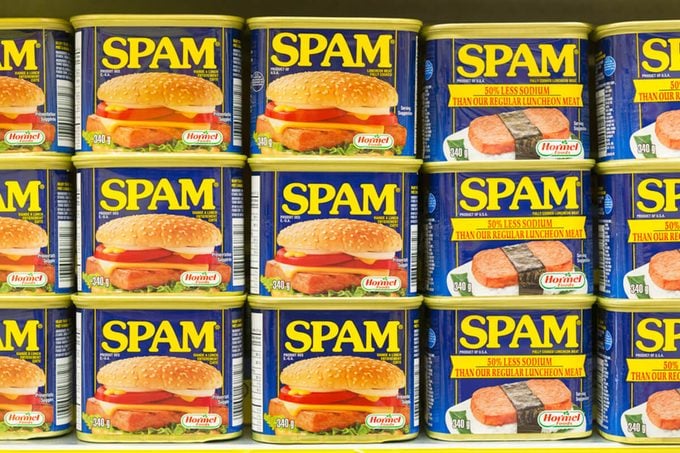Spam: The Wonder Food
Updated: Dec. 14, 2022
How can six simple ingredients cause so much controversy?

Spam: the ready-to-eat meat in a can that inspires laughs from some and wonder in others. Yes, that blue, square packaging with its bold, bright yellow letters can be instantly recognized from across the room. Even if you don’t know what the contents taste like, you’ll probably find yourself with an opinionated stance of the food (perhaps derived from those Spam-eating Vikings from Monty Python’s Flying Circus).
What exactly is it about these six simple ingredients—pork with ham, salt, water, potato starch, sugar, and sodium nitrite—that arouses controversy? From the outside, some might say these ingredients fit into a transparency model. After all, you can easily pronounce and recognize all six of them (but can you pronounce these?). On the other hand, Spam consumption is not only the antithesis of everything the whole foods movement stands for, but the word itself has become eponymous with things unwanted and unsolicited.
And yet, Spam has a purpose. In several parts of the world, it’s celebrated as a wonder food—and it’s always toward the top of food banks’ wish lists because it lasts. We take a peek at how we got to where we are today, and why you (might) want to give it a try.
Spam’s Origins
Spam came off the packaging lines in 1937. The goal: to produce an affordable canned meat item that was convenient enough to enjoy every day. Because of its shelf-stable status (and the fact that it wasn’t rationed like beef), Hormel began shipping the stuff abroad during World War II. By 1941, Hormel sent more than 100 million pounds of Spam to allied troops, and the easy-to-pack product became a staple food for GI’s during the war.
The kickback was horrendous—some soldiers joked that Spam was the real reason the war was awful—but those same soldiers brought the product back to their families nonetheless. Spam sales skyrocketed, and by 1959 Hormel had produced their one-billionth can of Spam. The rest is history. Spam had secured itself a spot in Americana, and by 2012 their production number reached 8 billion cans. Today, the 15 available varieties of Spam are shipped to 44 countries around the world.
How It Got Its Name
Spam’s website claims that the real meaning of the SPAM brand name is only known by a small circle of former Hormel executives (and probably Nostradamus). But, they go on to explain that a contest was held in 1937 to give the promising new product a name. Ken Daigneau, the brother of then Hormel Food vice president, entered with the name “SPAM.” Speculation indicates the name was a way to shorten “SPiced hAM.” Daigneau won $100 for the contest and, his name is mostly unknown, he went down in the history books as the Bestower of Appellations of one of the most iconic pork product in the world.
Where It’s Popular
If you live in a part of the world where U.S. troops were stationed during WWII, you’re probably pretty familiar with Spam. The product is most popular in these areas, with the most extreme example being Hawaii. The culture has completely adopted the ham-in-a-can product and consumes nearly 7 million cans of Spam products each year. You’ll find fried eggs and rice with spam for breakfast, Spam fried wontons as a snack, and sushi-inspired Spam musubi rolls at nearly every home and restaurant. You’ll even see Spam on McDonald’s breakfast menu!
You’ll also find a lot of Spam in Southeast Asia (where gift packs sell for as much as $45), the Philippines (where the restaurant Spam Jam sells all spam-inspired dishes), and Guam (where the annual consumption averages 16 cans per person).
What You Can Do with It
If you’re ready to give the wonder meat a try, the possibilities are endless. You can grill it, fry it, or eat it straight out of the can. Use it like sliced ham or bologna and pop it onto a sandwich bun, or fry it up like tofu and use it as a taco filling. Serve it over rice for lunch and dinner, or crisp up some potatoes and eat it as a breakfast hash. I’ve been able to figure out how to make Spam taste totally delicious for every meal—except dessert!
Give it a try for breakfast with this Morning Mix-Up recipe (or, if you’re going camping, this version). If you’re ready to go all out, toss together this Pork Pancit and add Spam like the home cook, Priscilla Gilbert, suggests. Soon, you’ll be singing, “Spam, wonderful Spam,” just like Monty Python’s Vikings. And for Spam and dessert lovers, this Spam figgy pudding may be the perfect after-dinner dish.




















